Farm Journal Test Plots: How Early Soybean Planting Pays
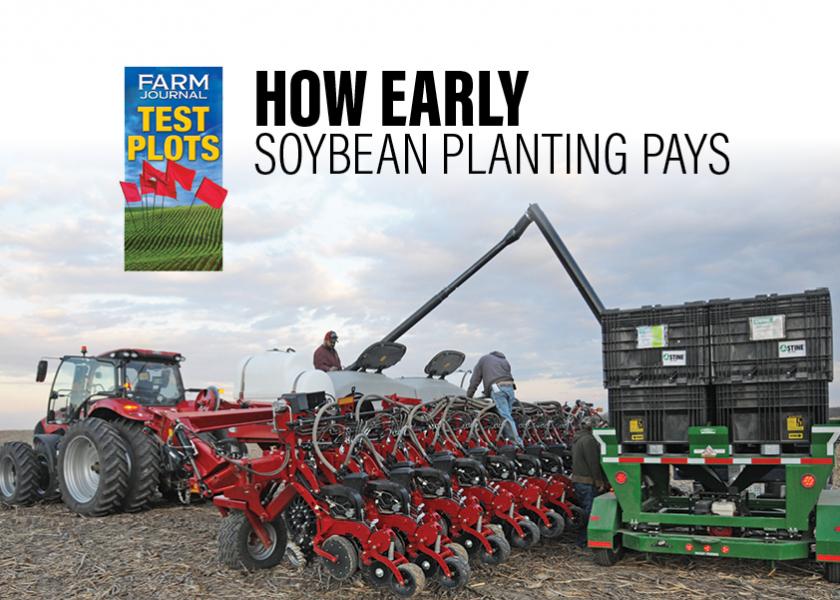
A 2020 Farm Journal study confirms earlier planting can boost yield, even if plants are nipped by a freeze or frost. That’s exciting news because, in many areas, products that control Sudden Death Syndrome have removed the last obstacle to early planting. Planting early allows soybeans to start flowering before the summer solstice, if they get big enough, instead of after the solstice as with normal planting dates.
“The earlier soybeans flower, the longer they spend in the reproductive stages, potentially resulting in more pods and more beans,” explains Farm Journal Field Agronomist Ken Ferrie. “Of course, you still must have adequate water and nutrients to fill those pods and produce big soybeans, but planting early can set the stage for higher yield.”
In the study (see graph below), Ferrie planted soybeans in maturity groups 2.4, 2.9, 3.5 and 4.1 on April 16 and June 1. Although all maturity groups were slow to emerge, and then had their stands thinned by frost, they all outyielded the June-planted soybeans by a considerable margin. “That’s because they all began to flower early,” Ferrie says.
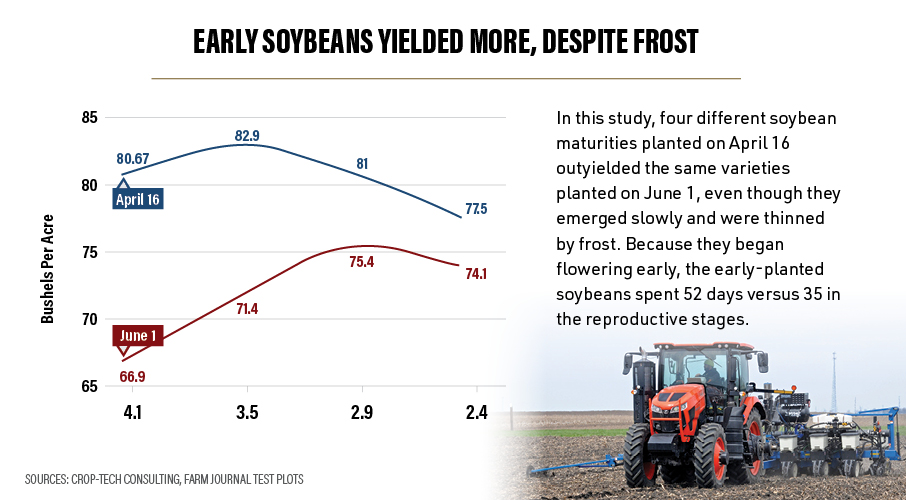
“Most years, with June 1 planting, the 3.5-to-4.1-maturity soybeans would have outperformed earlier-maturing varieties because they take longer to reach the end of the R6 stage,” Ferrie says. “But with no rain in August (the 13th driest on record in this area), the 4.1-maturity beans fell off in yield because they were trying to finish bean-fill without water. This was evident by the large number of small beans in the pods. That’s why we like to mix maturities to mitigate risk — we never know when a dry spell is going to show up.”
In the future, Ferrie hopes the ongoing study will shed more light on various aspects of early planting management listed below:
- Row spacing
So far, the study shows little yield advantage to 15" rows over 30" (compared with a 5-bu. or 6-bu. increase with normal planting dates). But narrow rows might aid weed control. - Population
The study has revealed there is no need to push soybean populations higher than 120,000 to 140,000 seeds per acre. “Higher population is not where yield comes from with early planting,” Ferrie says. “It comes from putting on more pods per acre — in essence, more beans per acre.” - Maturity
Soybean maturity comparisons have been inconclusive. “One thing we can say with early planting is to plant a mixture of maturity groups,” Ferrie says. “Plant your full-season varieties first, and finish with shorter-season varieties — the opposite of what you do when planting normally.” - Seedbed preparation
A little seedbed preparation, such as strip-till or vertical tillage, often results in faster emergence. In 2020, that sometimes proved to be detrimental — the early emerging soybeans looked good, but they were thinned out by frost; seeds planted in no-till or cover crop residue emerged more slowly and escaped the frost. “With this year’s results, we can’t prove earlier emergence made any difference in yield, compared to no-till,” Ferrie says. - Seed treatments
“In the Midwest, a seed treatment to protect against Sudden Death Syndrome is essential with early soybean planting because seeds may lay in the ground for 20 or 30 days,” Ferrie says. “There will be pressure from other diseases and insects, so an insecticide/fungicide seed treatment is always a good idea.” - Starter fertilizer
While starter fertilizer sometimes produces a visual response, the study has provided little evidence early appearance translates into increased yield.
Ultra Early Reaps Almost $18 Per Acre Advantage
The goal of planting soybeans ultra early (before April 15 in Michigan) is to maintain or increase yields while spreading out the workload at planting.
“After planting, seeds don’t just lay in the ground, they quickly imbibe water and start the germination process. However, growth and emergence can be slow,” says Farm Journal Field Agronomist Missy Bauer. “In our 2020 plots at two locations in Michigan, the ultra-early soybeans took 36 and 32 days to emerge. They were snowed on multiple times. Despite the delayed emergence, populations were within 3% to 4% of the normal planting date [late April/early May].”
An earlier planting date allowed flowering to occur near the summer solstice (R1 on June 21 and June 22), which was seven to eight days earlier than the normal planting.
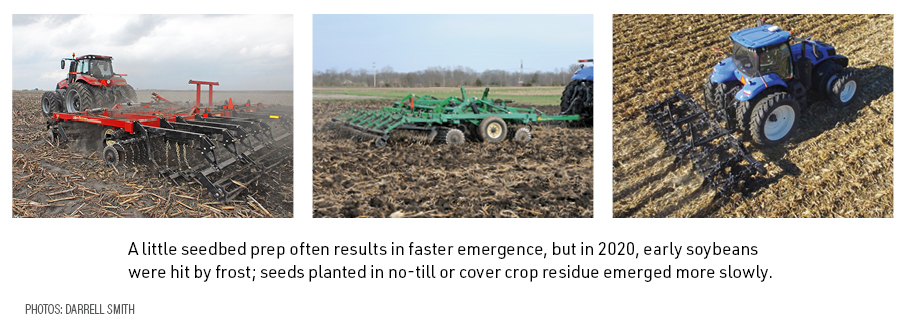
“It appears early flowering extends the reproductive stages and improves pods per node,” Bauer explains. “There were more nodes with pods on the ultra-early soybeans, which led to more pods per plant. Both the number of pods and seeds per plant were higher with the ultra-early planting as well.”
However, at both locations the timing of the rainfall in 2020 was more advantageous for the late April/early May soybeans in terms of seed size. The larger seed size made up in part for the lack of pod and seed count in the normal planting, narrowing the yield advantage of the ultra-early soybeans.
Even so, in 2020, the ultra-early soybeans in Michigan averaged 2 bu. more per acre than the late April/early May soybeans for a $17.76 per acre average advantage

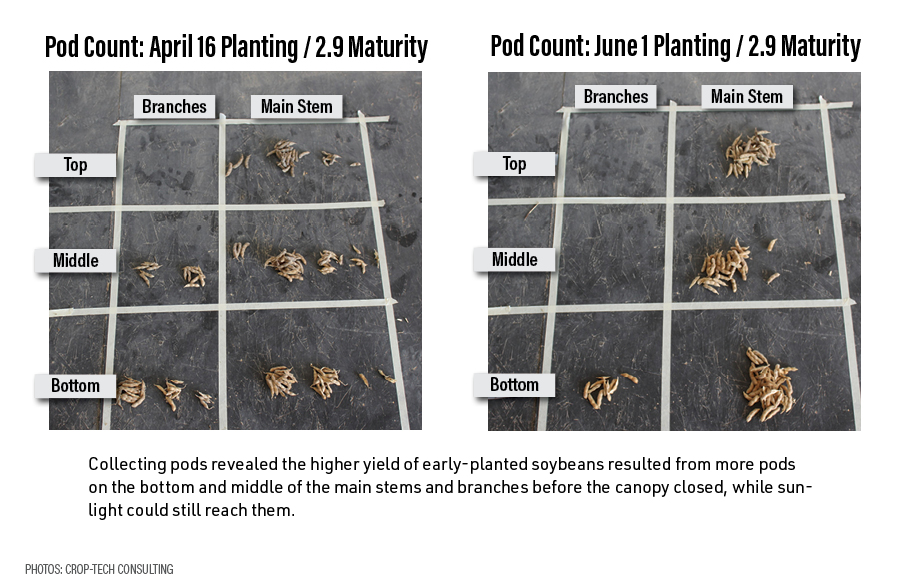
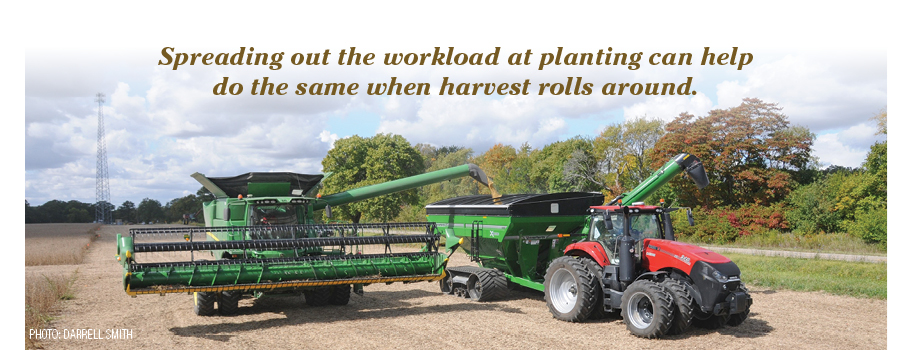
Thank You to Our Plot Partners
The Farm Journal soybean planting study is made possible by: AgriGold Seed/AgReliant Genetics, Case IH, Great Plains Ag, Kinze Manufacturing, Kubota Tractor Corporation, Martin Equipment, McFarlane Ag Manufacturing, New Holland Agriculture, Precision Planting, Unverferth Manufacturing Company and Yetter Farm Equipment, Michigan Soybean Promotion Committee, B&M Crop Consulting, Crop-Tech Consulting.







